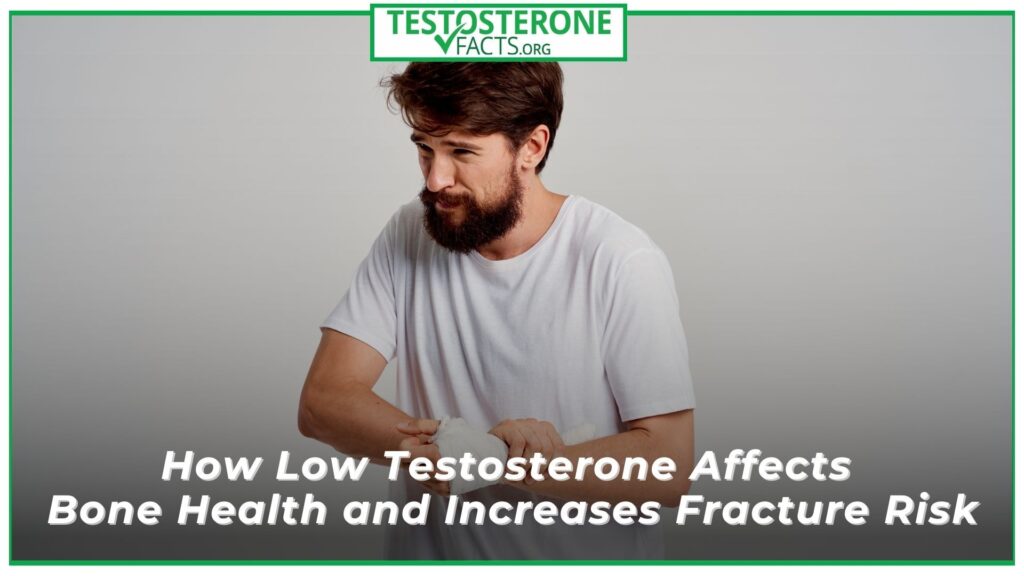
How Low Testosterone Affects Bone Health and Increases Fracture Risk
- TFacts Staff

Testosterone is a critical hormone in men, influencing not only reproductive functions but also overall physical health. One lesser-known but significant aspect of testosterone’s role is that there is a direct connection in the Testosterone and Bone Health.
Low testosterone levels in men can lead to a decrease in bone density, increasing the risk of osteopenia, osteoporosis, and fractures. As men age, testosterone levels naturally decline, which can disrupt the balance of bone remodeling and lead to weakened skeletal structures. In this article, we will explore how low testosterone affects bone health, increases fracture risk, and why maintaining healthy testosterone levels is essential for long-term skeletal integrity.
Table of Contents
ToggleTestosterone and Bone Health: The Connection
Testosterone and bone health go hand-in-hand. Testosterone regulates bone remodeling by stimulating osteoblasts, which form new bone, and inhibiting osteoclasts, which break down old bone. It also enhances calcium absorption and retention, ensuring bones stay strong. This balance is vital for maintaining bone density and strength, especially with aging.
The Impact of Low Testosterone on Bone Health
The decline in testosterone associated with aging has profound effects on bone health. Several mechanisms contribute to the deterioration of bone density in men with low testosterone:
1. Reduced Osteoblast Activity
Testosterone directly stimulates osteoblasts, the cells that produce new bone tissue. When testosterone levels drop, the osteoblasts become less active, resulting in reduced bone formation. Over time, this can lead to a significant reduction in bone density, especially in weight-bearing areas such as the spine, hips, and legs.
A lack of new bone formation not only weakens the skeletal structure but also increases the likelihood of developing osteopenia or osteoporosis.
2. Increased Osteoclast Activity
In contrast to osteoblasts, osteoclasts are responsible for breaking down bone tissue. In men with low testosterone, the activity of osteoclasts becomes more pronounced. This leads to an increase in bone resorption, where old bone is broken down faster than it can be replaced by new bone.
As a result, the bones lose mass and become more porous, significantly increasing the risk of fractures, particularly in areas like the wrists, hips, and spine.
3. Calcium and Vitamin D Absorption
Testosterone plays an essential role in calcium metabolism and vitamin D absorption. Both of these nutrients are critical for bone mineralization and maintaining bone density.
When testosterone levels decline, the body’s ability to absorb calcium and vitamin D diminishes, leading to weaker bones. Without sufficient calcium and vitamin D, the bones cannot retain the minerals they need to stay strong, further contributing to bone fragility and increasing the risk of fractures.
4. Muscle Weakness and Physical Activity Decline
Low testosterone levels are also associated with a decrease in muscle mass and strength, a condition known as sarcopenia. Muscle strength is vital for supporting the skeleton and protecting it from fractures.
As testosterone levels decline, men may experience decreased muscle function, leading to reduced physical activity. Since weight-bearing exercises are essential for stimulating bone formation, the lack of physical activity exacerbates bone loss, further weakening the skeleton.
Increased Fracture Risk Due to Low Testosterone
Low testosterone increases fracture risk by leading to osteopenia and potentially osteoporosis, where bones become weak and fragile. Men with low testosterone face higher risks of vertebral and hip fractures, with vertebral fractures causing back pain and spinal deformities.
Research shows a direct link between low testosterone and increased fracture risk, even after accounting for factors like age and BMI. Studies in the Journal of Bone and Mineral Research and Osteoporosis International confirm this association.
Addressing Low Testosterone and Bone Health
Given the strong connection between testosterone and bone health, men with low testosterone levels should consider strategies to mitigate their risk of fractures. One potential treatment option is testosterone replacement therapy (TRT), which involves restoring testosterone levels to normal through synthetic hormones. Studies have shown that TRT can increase bone mineral density in men with testosterone deficiency, particularly in the lumbar spine and hip, where fracture risk is highest.
In addition to TRT, lifestyle modifications can also improve bone health. Men with low testosterone levels should focus on consuming a diet rich in calcium and vitamin D to support bone mineralization. Weight-bearing exercises such as walking, running, or resistance training can help stimulate bone formation and improve muscle strength, providing additional support to the skeleton.
Testosterone Therapy as a Potential Solution
For men with low testosterone levels and associated bone health issues, testosterone replacement therapy (TRT) can be a viable treatment option. TRT helps restore normal testosterone levels, which can improve bone mineral density and reduce the risk of fractures. Several studies have shown that TRT can increase bone density, particularly in the lumbar spine and hips, areas most vulnerable to fractures.
In a study published in the Journal of Clinical Endocrinology & Metabolism, researchers found that men undergoing testosterone therapy experienced significant improvements in bone density, along with reduced markers of bone resorption. The therapy helps restore the balance of bone remodeling, promoting bone formation and inhibiting excessive bone loss. Additionally, TRT has been shown to improve muscle strength and physical function, which can reduce the risk of falls and further protect against fractures.
Conclusion
Low testosterone disrupts the balance between bone formation and resorption, reducing bone density and increasing fracture risk. This leads to conditions like osteopenia and osteoporosis, making bones more susceptible to fractures, especially in the spine, hips, and wrists.
Understanding the relationship between testosterone and bone health is crucial for addressing these risks and preventing long-term complications such as fractures. Through appropriate medical interventions and lifestyle changes, men with low testosterone can take proactive steps to protect their bone health and reduce their fracture risk.
Frequently Asked Questions
1. How does low testosterone affect bone health?
Low testosterone levels can lead to a decrease in bone density because testosterone plays a crucial role in maintaining bone mass. It helps in the production of bone tissue and regulates bone turnover, the process where old bone is replaced with new bone.
Without adequate testosterone, the bones become weaker, making them more susceptible to fractures and osteoporosis.
2. Why does low testosterone increase the risk of fractures?
Testosterone supports the strength and density of bones by promoting bone mineralization. When testosterone levels drop, the bones lose minerals, becoming thinner and more fragile.
This reduced bone density significantly increases the risk of fractures, especially in areas like the hips, spine, and wrists, which are common sites of osteoporosis-related fractures.
3. Can testosterone replacement therapy help improve bone health in individuals with low testosterone?
Yes, testosterone replacement therapy (TRT) can help improve bone density in individuals with low testosterone. By restoring normal testosterone levels, TRT stimulates the production of new bone cells, improving bone strength and reducing the risk of fractures.
However, it is important to consult a healthcare provider to determine if TRT is appropriate and safe for your specific health condition.




